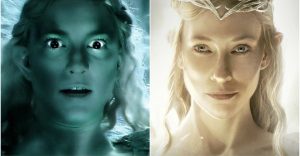20 Most Inaccurate Movie Character Portrayals Of Mental Illness

Content Warning: The following article contains discussions of mental health conditions and violence.
From savants performing enormous computations in their heads to schizophrenics having episodes of raging violence and mayhem, Hollywood has been stereotyping mental illness for decades. Mental illness manifests in a variety of ways, and Hollywood has been known to either downplay symptoms entirely or exaggerate them wildly for the sake of a movie’s plot, both of which afford dangerously inaccurate perceptions to the public.
For years, dissociative identity disorder cannot seem to be portrayed as anything other than terrifyingly violent and intrusive, whether in Fight Club or Psycho. Inaccurate depictions of mental illness do as much to woefully misinform as they do to sensationalize, all in the name of entertainment.
Updated on February 3rd, 2022 by Kayleena Pierce-Bohen: In 2022, two years after the start of a global pandemic, it becomes more important than ever to focus on mental health, and the examination and exploration of its challenges have indicated an obligation on behalf of filmmakers for mental illnesses to be conveyed with convincing accuracy and dignity in the media.
Unfortunately, there’s a long list of movies that continue to portray characters’ mental illnesses in ways that sensationalize their symptoms by making them incredibly violent, musical geniuses, or cured by the power of love.
Kevin Wendell Crumb
Split

M. Night Shyamalan’sSplitis as troubled as its main antagonist’s emotional state. Shyamalan is said to have consulted doctors about the reality of dissociative identity disorder before making the film, but the terrifying way it’s represented suggests he didn’t take much of their commentary seriously.
The movie focuses on Kevin (James McAvoy) and his abduction of three young girls. He interacts with them as different personalities (he has 23). The audiences primarily see 4 (Dennis, Patricia, Hedwig, and Barry), but eventually “The Beast” (a dangerous amalgamation) appears, pure cinematic fiction, and the graphic nature of his violence paints people with dissociative identity disorder in a horrific light.
Charlie Baileygates
Me, Myself, and Irene

With Jim Carrey in the lead, exaggeration was bound to occur in Me, Myself, and Irene. His mild-mannered Charlie character combined with the tough-talking Hank is supposed to be a manifestation of dissociative identity disorder and schizophrenia. The film’s dark comedy comes from the Dr. Jekyll and Mr. Hyde antics that ensue when one personality tries to assert dominance over the other.
Schizophrenia is characterized by delusions and paranoia but has no sign of multiple personalities, and as always with dissociative identity disorder, two personalities are not aware of each other’s presence. They cannot work together to fight enemies, nor can they fight each other for the chance to marry the pretty girl because the narrative says so.
Billy, Henry, Jack & Albert
The Dream Team

The Dream Team explores the ramifications of a group of mentally ill psychiatric patients permitted to leave the hospital ward and see a baseball game. Their supervisor is knocked unconscious, and they find themselves free to wander the streets of New York City led by Billy (Michael Keaton). The characters are all stereotypes, with every sort of psychological disorder from obsessive-compulsive disorder to schizophrenia.
Billy is a nihilistic author, Henry (Christopher Lloyd) is a mailman who “went postal”, Jack (Peter Boyle) believes himself to be something akin to Jesus, and Albert (Stephen Furst) is compulsively obsessed with baseball broadcasts. The message of the movie posits that all the men really need is a day in the “Real World” instead of psychotherapy and medications.
Joon
Benny and Joon

Benny and Joon does a dangerous disservice at certain points to people that have schizophrenia. When Juniper “Joon” (Mary Stuart Masterson) befriends Sam (Johnny Depp), she finds a kindred spirit. Except for the fact that Joon isn’t just eccentric in the way Sam is – she has a personality disorder, one that her older brother Benny (Aidan Quinn) has to look out for.
Joon runs away to be with Sam, and he soon realizes that her condition may require too much care. The movie goes for some cheap humor when Joon directs traffic with a ping pong paddle and unfortunately seems to convey the message that meeting another oddball is a fine replacement for psychotherapy, medication, and professional help. Despite this, the movie has saving graces and can also be considered one of the better representations of mental illness in movies.
Andrew Largeman
Garden State

Garden State teaches us that if you’re diagnosed with a mental illness but meet the right person, you won’t have to depend so much on real medication and therapy. Such is the case for Andrew (Zach Braff) who’s taken antidepressants all his life for clinical depression, which only gets worse with the death of his mother. When he returns to his hometown for the funeral, he meets a bizarre girl (Natalie Portman) who shows him how to feel again.
He goes off his medication, because in his mind it was the pills all along that made his life joyless, not the depression! This mistakenly makes people who suffer from depression think they can just decide to be happy one day, and that it’s their lack of willpower that’s preventing them from being so. In reality, it’s genetics and/or a chemical imbalance in the brain.
Christian Wolff
The Accountant

The action-thriller The Accountantstars Ben Affleck as a CPA who served time for cooking the books for the world’s worst criminals. Upon his release, he starts up a tax firm to quietly attempt to reintegrate into society by day and go after the criminals he once worked for by night.
Because his autism allows him to be hyper-focused, and he has elite martial arts training, he’s supposed to be believable as an elite assassin. Unfortunately, as the film suggests, it also means he has no social skills whatsoever, can’t talk to women, and has the need to “stim” constantly (a repetitive action an autistic person does to help regulate a state of extreme stress on their system).
Bob Wiley
What About Bob?

InWhat About Bob? Bill Murray plays Bob, a man with several psychological disorders and phobias who becomes dependent on his doctor (Richard Dreyfuss) to guide him through his everyday challenges. When Dr. Marvin tries to go on vacation with his family, Bob’s neediness can’t allow him to be separated from his health professional.
To treat someone as incapable as Bob, whose personality disorders make him incredibly clingy and unable to function without being taken care of, would take years of medication and therapy. Gaining acceptance from Dr. Marvin’s family would no more help him than being tied to the mast of a sailboat to “conquer” his fears (as the film suggests).
Arthur Fleck
Joker

This origin story involving Gotham City’s Clown Prince of Crime and Batman’s greatest nemesis examines the role that society plays in forming a villain. It posits that a character like Arthur Fleck, derided by his peers for his unique mental illness (laughing or crying uncontrollably in inappropriate settings) could become The Joker if ostracized enough.
His mental illness makes him victimized, and the movie does a commendable job of highlighting society’s fear about what it doesn’t understand. But that fear of the obvious signs of mental illness quickly becomes validated when Fleck no longer takes his medication and becomes dangerously violent. His “descent into madness” requests viewers to have more compassion for those with mental illness, then reduces them to a cluster of harmful stereotypes.
Norman Bates
Psycho

While it’s lauded as one of the most effective thrillers cinema has ever seen, Psycho comes by its reputation by sensationalizing mental illness. Norman Bates, the bashful caretaker of the Bates Motel, is overly attached to his mother, and witnessing her become attached to new men and dividing her attention drives him into a rage. He poisons her and her lover and assumes ownership of the motel.
When Bates meets Marian, a lovely traveler that stops in for a room, he ends up violently murdering her in the shower. This was said to be the personality of “Mother” taking over and becoming jealous of his affection for another woman. People that have dissociative identity disorder don’t have a personality that becomes “aware” of the other personality, and they are not characterized by extreme violent rages.
The Narrator
Fight Club

At its core, Fight Club is about a man with dissociative identity disorder struggling to live in a world that requires a dominant personality to take charge. The Narrator uses the charismatic Tyler (Brad Pitt) as a coping mechanism. Tyler takes over whenever The Narrator can’t find purpose in his life (because “everyone is special”, no one is). The book actually coined the term “snowflake” to describe The Narrator’s disassociation from society.
Where the film gets The Narrator’s mental illness wrong is implying that the mundanity of his daily struggles triggered a mental break allowing the dissociative identity disorder to emerge. In reality, it would have taken severe trauma. And just as in Pyscho, each personality wouldn’t be aware of the other one, much less be able to have full-on conversations.
Teddy Daniels
Shutter Island

While a taut psychological thriller, Martin Scorsese’s Shutter Island is mired in inaccurate depictions of mental illness in order to sensationalize the plot points they directly influence. It begins with a U.S. Marshal arriving at the fortress-like Ashecliffe Hospital in search of a murderous patient who’s disappeared under mysterious circumstances, and spirals into a confrontation with his own psyche as the hospital’s history is revealed.
The twist at the end can only occur because of the highly-dramatized nature of the mental illness (delusional disorder in this case), and the suspension of disbelief that a resilient person, having experienced family trauma, can break through their delusional reality during treatment, and then revert back to it like a stuck record.
Ellis Fielding
Loose Cannons

In this buddy cop action movie, Gene Hackman and Dan Aykroyd team up as a by-the-book lawman with a no-nonsense attitude, and a brilliant detective with an eccentric personality. One’s brawn and the other’s deductive reason are needed to solve the crime of the century, and together they’re a couple of “loose cannons”.
Not only does the movie not work because the leads share no chemistry, Aykroyd’s savant detective has dissociative identity disorder, which is played entirely for laughs. He replicates the personalities of popular television characters and is responsible for nearly getting everyone around him killed on multiple occasions. It depicts his mental illness like being a werewolf or The Hulk; something that gets triggered and then becomes a crazy party trick.
Nana & Pop Pop
The Visit

Respected horror director M. Night Shyamalan is known for making movies that pull the rug out from under audiences in terrifying ways. In The Visit, he uses an innocent visit between two children and their grandparents to subvert expectations, creating an environment perfect for a confrontation of uncomfortable truths.
Shyamalan uses the concept of “sundowning” to accomplish his task, a very real neurodegenerative disease that often affects people with Parkinson’s or Alzheimer’s. However, unlike in the movie, which shows the children’s grandmother Doris projectile vomiting and rabidly wielding butcher knives, those who suffer from it usually have dementia-related impairments, like forgetting who they are or those around them, becoming increasingly frustrated with simple tasks, and occasionally yelling.
Alexandra Forest
Fatal Attraction

Glenn Close was nominated for an Academy Award for portraying a mentally ill woman obsessed with a married man, but over three decades later even, according to Prevention, Close regrets the way Fatal Attraction handled mental health, specifically her character’s bipolar disorder. In her eyes, the movie did nothing but reinforce the stigma that people suffering from BPD are violently unstable.
To her credit, Close did extensive research for the part and even went so far as to speak with psychiatrists and invent an abusive past to somewhat explain her characters’ erratic actions. While it’s true, those with bipolar disorder can be highly emotionally reactive and express anger inappropriately, their symptoms are rarely like anything seen in Alex Forrest, who boils her lovers’ pet on the stove, pours acid on his car, and threatens the lives of his family.
Aaron Stampler
Primal Fear

Edward Norton has made a reputation out of playing unstable characters, beginning with his defining performance in Primal Fear, where he plays an altar boy convicted of murdering Chicago’s archbishop. A hotshot attorney takes his case, and while the Church’s secrets are revealed, so is the mental illness exhibited by Norton’s Aaron Stampler.
The end suggests that Stampler manipulated his lawyer, his psychiatrists, and the jury into believing he committed the crime when in reality that persona was a front for another more insidious one. By making dissociative identity disorder the “twist”, it amplifies the fear society has of letting someone “get off by reason of insanity”. It perpetuates the concept that anyone with a mental illness is a boogeyman, that they have control over their symptoms, and can turn them on and off to manipulate everyone around them.
Virginia Cunningham
The Snake Pit

There is something terrifying about waking up in a mental institution with no memory of your arrival, nor the names of doctors, nor even your spouse. This scenario is precisely what occurs for Virginia Cunningham (Olivia de Havilland), who has been committed based on a diagnosis of schizophrenia.
Because this movie was made in 1948, it stands to reason that the available literature on schizophrenia was based on extremely outdated information. The film chose to tackle the difficult subject matter at a time when the general public was highly suspicious of “female hysteria”. While it’s praised for its focus on the often agonizingly slow recovery process, it has many mental breakdowns that point to the fragility of the female psyche specifically, and part of Virginia’s “cure” is becoming a subservient wife to her husband.
Eve
The Three Faces Of Eve

Joanne Woodward won an Academy Award for Best Actress for her portrayal of three different personalities all found within the same person –Eve White, Eve Black, and Jane– but the praise for her portrayal of someone diagnosed with dissociative identity disorder overshadow the extreme grievances The Three Faces Of Eve presents about the condition.
Eve’s search for the truth about her different emerging personalities, some of whom are excessively violent, takes her to Dr. Luther, who does a number of hypnotherapies on her in an attempt to draw out the source of the trauma that created these identities. The therapy all happens too quickly and too succinctly to be believable, and the ending (in which Eve remarries and reunites with her daughter) glosses over the trauma she would have caused her family in the first place.
David Heflgott
Shine

It can be a tricky subject to accurately portray a real person with a mental illness in film, such as David Helfgott, the pianist who had a mental breakdown and was moved in and out of institutions for years. Considered one of Geoffrey Rush’s best movies, Shine examines David’s life during that time, interlaced with flashbacks to practicing piano with his father Peter Helfgott, and offers a sympathetic look at a man embracing a new way of life rather than running from it.
After his breakdown, David is depicted as being able to return to the stage, when in fact he would not have been able to play without severe technical issues brought on by his schizophrenia, as the “genius” term often fails to recognize the auditory, visual, cognitive, and other physical impairments that the diagnosis brings on.
Parry
The Fisher King

While some aspects of The Fisher King are considered to be fantasy based on the narrative itself, the focus on the very real mental illnesses suffered by Parry, one of its central figures, should not be considered in the same way. He is presented as a delusional homeless man suffering from schizophrenia and dissociative identity disorder, who aids an insensitive radio DJ on a path to redemption, and comes across more like a caricature than a real person.
So much of Parry’s hallucinations (such as the Red Knight) and outbursts happen in ways conducive to drive the plot of seeking the Holy Grail –and giving its neurotypical hero character a second chance at life– rather than conveying the truly erratic ways in which they would manifest in a person with schizophrenia and dissociative identity disorder.
Romulus
The Caveman’s Valentine

In The Caveman’s Valentine, Samuel L. Jackson portrays Romulus, once a great composer now a disheveled man who lives in one of New York’s parks. He emerges from his cave to find a young boy frozen to death on Valentine’s Day, and has an overwhelming desire to try to find the man responsible for what he believes to be his murder.
Romulus is portrayed as both a crazed boogeyman and at times a completely lucid person, who somehow (despite having severe hallucinations and fits) can undertake a complicated investigation. Not only would a schizophrenic man at his level lack the cognitive ability to do so without active and intense treatment, but he’s also portrayed as incredibly violent when people with schizophrenia are no more likely to exhibit violent behavior than anyone else with a mental illness. It’s a sensationalized myth specifically used to increase the tension of the movie.
About The Author


















